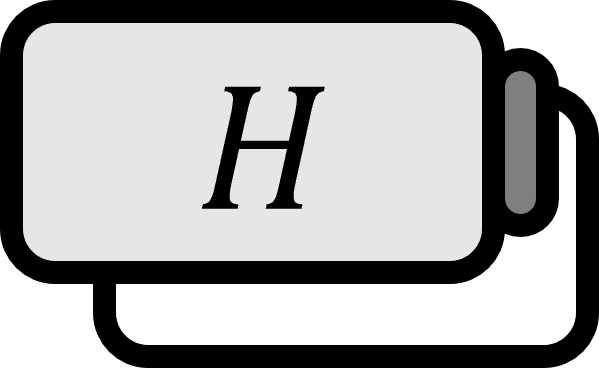Hilbert Spaces are Reflexive: A Proof
Theorem
Hilbert Space $H$ is reflexive: $$ H^{\ast \ast} \approx H $$
- $X^{\ast}$ is the dual space of $X$, and $X^{\ast \ast}$ represents the double dual.
- $X \approx Y$ means that $X$ and $Y$ are isometric.
Description
Although it is brief and straightforward, the fact that there is no need to consider anything larger than the dual space when studying Hilbert spaces is very good.
Proof
Part 1. $(H^{ \ast } , \| \cdot \| )$ is a Hilbert space
Riesz Representation Theorem: Let’s assume $H$ is a Hilbert space. For linear functionals $f \in H^{ \ast }$ and $\mathbf{x} \in H$ of $H$, there exists a unique $\mathbf{y} \in H$ that satisfies $f ( \mathbf{x} ) = \left\langle \mathbf{x} , \mathbf{y} \right\rangle$ and $\| f \| = \| \mathbf{y} \|$.
Let’s define the function $\left\langle \cdot , \cdot \right\rangle^{ \ast } : H^{ \ast } \times H^{ \ast } \to \mathbb{C}$ as $\displaystyle \left\langle f, g \right\rangle^{ \ast } : = \left\langle \mathbf{y}_{g}, \mathbf{y}_{f} \right\rangle = f ( \mathbf{y}_{g} )$, where $\mathbf{y}_{f}, \mathbf{y}_{g} \in H$ are the elements satisfying $\| f \| = \| \mathbf{y}_{f} \|$ and $\| g \| = \| \mathbf{y}_{g} \|$ from the Riesz Representation Theorem.
Then, $\left\langle \cdot , \cdot \right\rangle^{ \ast }$ satisfies the following three conditions, making it the inner product of $H^{ \ast }$:
(i): $\left\langle \lambda f_{1} + f_{2} , g \right\rangle^{ \ast } = ( \lambda f_{1} + f_{2} ) ( \mathbf{y}_{g} )= \lambda f_{1}( \mathbf{y}_{g} ) + f_{2} ( \mathbf{y}_{g} ) = \lambda \left\langle f_{1}, g \right\rangle^{ \ast } + \left\langle f_{2}, g \right\rangle^{ \ast }$
(ii): $\left\langle f , g \right\rangle^{ \ast } = \left\langle \mathbf{y}_{g} , \mathbf{y}_{f} \right\rangle = \overline{ \left\langle \mathbf{y}_{f} , \mathbf{y}_{g} \right\rangle } = \overline{ \left\langle g , f \right\rangle^{ \ast } }$
(iii): $\left\langle f , f \right\rangle^{ \ast } = \left\langle \mathbf{y}_{f}, \mathbf{y}_{f} \right\rangle = \| \mathbf{y}_{f} \|^{2} \ge 0$ and $\left\langle f , f \right\rangle^{ \ast } = \| \mathbf{y}_{f} \|^{2} = 0 \iff \mathbf{y}_{f} = 0 \iff f = 0$
Properties of Linear Operators: If $Y$ is a Banach space, then $(B(X,Y), \left\| \cdot \right\| )$ is a Banach space.
Since $Y=\mathbb{C}$ is a Banach space, $(B(X,Y), \left\| \cdot \right\|) = (H^{\ast}, \left\| \cdot \right\|)$ is also a Banach space. $H^{\ast}$ being a complete space with an inner product defined makes it a Hilbert space.
Part 2.
Let’s define the function $\Phi$. Let’s define $\Phi : H \to H^{\ast \ast}$ as $\Phi (\mathbf{x}) := \phi_{\mathbf{x}} (f) = f(\mathbf{x})$ using the function $\phi_{\mathbf{x}} \in H^{\ast \ast}$, which substitutes $\mathbf{x} \in H$ into $f \in H^{ \ast }$.
Part 3. $\Phi$ is linear
Since $f \in H^{ \ast }$, $\Phi ( \lambda \mathbf{x} + y) = f ( \lambda \mathbf{x} + y) = \lambda f ( \mathbf{x} ) + f ( y) = \lambda \Phi ( \mathbf{x} ) + \Phi ( y)$
Part 4. $\Phi$ is injective
If we say that $\mathbf{x} \in \ker \Phi$, then $\mathbb{0} = \Phi (\mathbf{x}) = f(\mathbf{x})$ hence $\mathbf{x} \in \ker f$Taking the substitution function from the Riesz Representation Theorem, we get $\phi_x (f) = f(\mathbf{x}) = \left\langle \mathbf{x} , \mathbf{y}_{f} \right\rangle = \mathbb{0}$ This must be true regardless of $\mathbf{y}_{f}$, so $\mathbf{x} = \mathbb{0}$ must be true.
Properties of Kernel: $\ker \Phi = \left\{ \mathbb{0} \right\} \iff \Phi$ is injective.
Since $\ker \Phi = \left\{ \mathbb{0} \right\}$, by the properties of the kernel, $\Phi$ is injective.
Part 5. $\Phi$ is surjective.
As already shown in Part 1. that $H^{ \ast }$ is a Hilbert space, we can use the Riesz Representation Theorem.
Part 5-1.
For $F \in H^{\ast \ast} ( F : H^{\ast \ast} \to \mathbb{C})$, there uniquely exists $g_{F} \in H^{ \ast }$ that satisfies $F( \cdot ) = \left\langle \cdot , g_{F} \right\rangle^{ \ast }$ and $\| F \| = \| g_{F} \|$.
Part 5-2.
For $g_{F} \in H^{ \ast } ( g_{F} : H^{ \ast } \to \mathbb{C})$, there uniquely exists $\mathbf{x}_{g_{F}} \in H$ that satisfies $g_{F} ( \cdot ) = \left\langle \cdot , \mathbf{x}_{g_{F}} \right\rangle$ and $ \| g_{F} \| = \| \mathbf{x}_{g_{F}} \| $.
$$ \begin{align*} F(f) =& \left\langle f , g_{F} \right\rangle^{ \ast } & \text{by Part 5-1.} \\ =& \left\langle f , g_{F} \right\rangle^{ \ast } &\text{by definition of } \left\langle \cdot , \cdot \right\rangle^{ \ast } \\ =& \left\langle \mathbf{x}_{g_{F}} , \mathbf{y}_{f} \right\rangle^{ \ast } &\text{by definition of }\left\langle \cdot , \cdot \right\rangle \\ =& f \left( \mathbf{x}_{g_{F}} \right) & \text{by Riesz Representation Theorem} \\ =& \Phi ( \mathbf{x}_{g_{F}} ) &\text{by definition of } \Phi \end{align*} $$
Therefore, for all $F(f) \in H^{\ast \ast}$, there exists $\mathbf{x}_{g_{F}} \in H$ that satisfies $\Phi ( \mathbf{x}_{g_{F}} ) = F(f)$, making $\Phi$ surjective.
Part 6. $\Phi$ preserves the norm.
From the definition of $\Phi$, because $\Phi ( \mathbf{x}_{g_{F}} ) = \phi_{ \mathbf{x}_{g_{F}} } (f)$,
$$ \Phi ( \mathbf{x}_{g_{F}} ) = \phi_{ \mathbf{x}_{g_{F}} } (f) = F(f) $$
In other words,
$$ \left\| \Phi ( \mathbf{x}_{g_{F}} ) \right\| = \left\| \phi_{ \mathbf{x}_{g_{F}} } \right\| = \left\| F \right\| $$
But from Part 5-1., we had $\| F \| = \| g_{F} \|$, and from Part 5-2., we had $\| g_{F} \| = \| \mathbf{x}_{g_{F}} \|$,
$$ \left\| \Phi ( \mathbf{x}_{g_{F}} ) \right\| = \| \mathbf{x}_{g_{F}} \| $$
Summarizing from Part 2. to Part 6., we can see that $\Phi$ is isometric.
■
